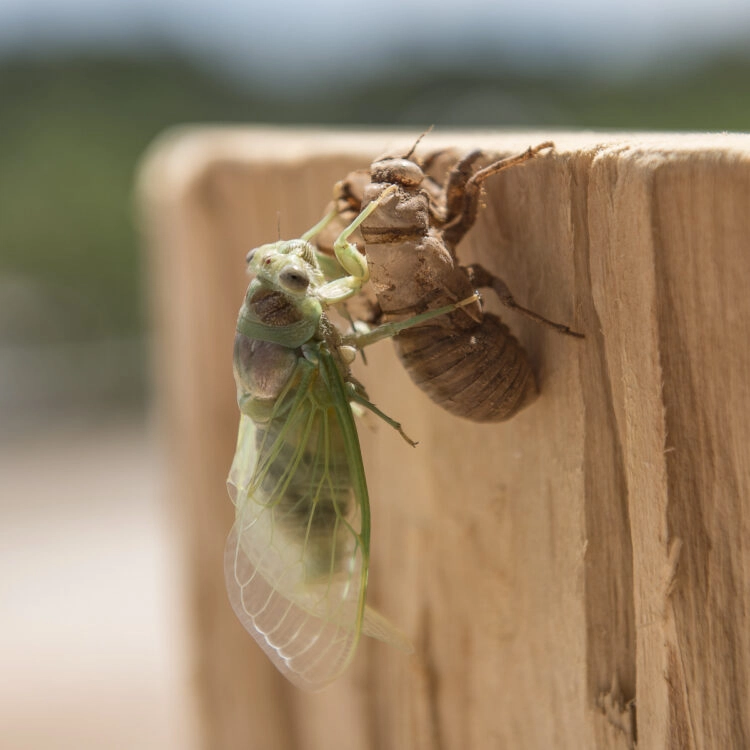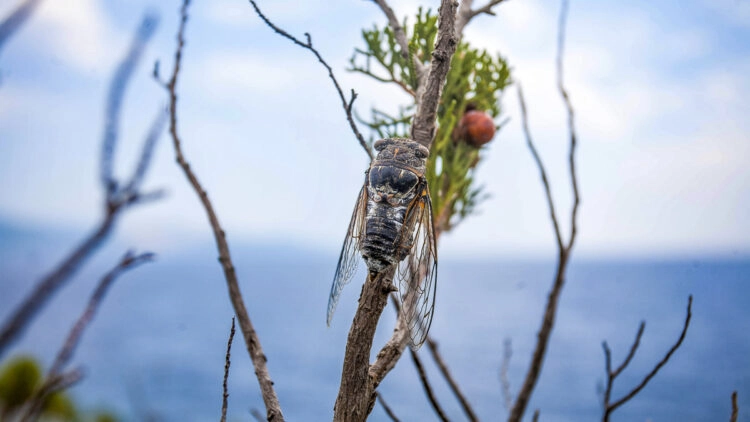They have existed since the Eocene, have been an integral part of mythology, art and folklore for thousands of years, consist of more than 4,000 species worldwide, you can make fever preparations from them and some even eat them, but most travelers to Croatia are well acquainted with them through their song: the singing cicadas. Portrait of the small, inconspicuous singers from the SeaHelp editorial team.
“Happy live the cicadas, for they have silent wives,” wrote the Greek poet Xenarchos a long time ago, because it was already known to the ancient Greeks that the song of the six-footed insects, 1.4 to 11 centimeters in size, comes exclusively from the males.
Singing cicadas were revered as a symbol of the human soul
However, singing cicadas formed the basis of numerous legends and myths not only in ancient Greece, but also in ancient China and Japan, as well as in North America. In Africa and in ancient Egypt they were even revered as a symbol of the human soul, as well as a symbol of immortality, rebirth, a long life, and partly also for eroticism.
Although there are more than 4,000 known species of the heat-loving song cicadas worldwide, which are mainly distributed in the tropics and subtropical zones – the largest representatives of this family live in India, southern China and the Greater Sunda Islands, but even in Europe, the song cicadas occur with still 61 species in 12 genera mainly in the Mediterranean region; about 13 to 14 species in seven genera advance into thermally particularly favored regions of Central Europe, including Croatia.
Belongs for many Croatia vacationers: the song of cicadas
In addition to their unusual life – song cicadas go through five larval stages and have a development period of several years – the special significance of the beaked cicadas (scientific name Cicadidae), however, arises from their specific song, which for many Croatia tourists simply belongs in the anchorage, but for others is perceived as disturbing noise. In addition, the shy insects, perfectly adapted to their environment in terms of color, are almost never seen, which leads many people to fearful behavior towards the animals.
However, there is no reason for fearful behavior or even rejection of the insects: all singing cicadas are completely harmless to humans, because as so-called xylem suckers they feed exclusively on the sap of various woody and herbaceous plants with the help of their proboscis; the larvae living underground suck the sap from plant roots.
What makes this particular family within the round-headed cicadas so special, however, is their ability to produce sounds audible to humans. To do this, the males have specially developed drum organs (tymbals) on the sides of the first abdominal segment, just behind the base of the hind wings. By means of attached muscles (singing muscles), outwardly curved sound plates reinforced by ribs are set into vibration.
The actual sound is produced by indentation (muscle pull) and rebound (inherent elasticity). Directly under the singing muscle, a large air sac in the hollow abdomen provides the necessary resonance.
Decidedly too much for some tourists: song cicadas can be as loud as a jackhammer
These organs can be used to produce sounds up to 900 hertz and volumes up to 120 decibel can be generated. And this is exactly where the problem lies: at about 120 decibels is the pain threshold of the human ear. A chainsaw or a jackhammer is similarly loud.
For some tourists, this is decidedly too much – if they want to change the booked vacation location, they can only hope for the goodwill of the landlord, because the cicada song does not usually justify a legal claim. Sailors have it there much more simply – sounds the Sing noise in the otherwise quiet anchorage once nevertheless around a few decibels too loudly, they shift the boat simply a few meters outside.
Interesting to know: although all cicada species emit sound or vibration waves for communication, only the majority of the representatives of the Cicadidae are able to produce sounds audible to humans. The song of males is mainly used to attract females, but it is also used to establish territorial boundaries.
The cicadas sing particularly loudly during the mating season
On the other hand, it has not yet been conclusively clarified why the males sing almost continuously during the day or at dusk, of all times. However, it is a fact that it becomes particularly loud when the animals gather for mating often in large numbers in trees, bushes or even in the low vegetation.
Incidentally, in Greece, the first plastic representations of the animals are known from prehistoric times: in tombs of the city of Mycenae (2000 BC) were found the models of cicada larvae, which indicate the importance of cicadas as symbols of immortality and long life.
Singing cicadas were considered as a model of the human soul
Song cicadas, however, as metaphors for the art of singing and eloquence (muses) and immortality, were much more deeply rooted in the Greeks’ imagination. According to the Phaedrus, a text by the philosopher Plato (429-347 B.C.), cicadas are believed to have been conceived as messengers of the muses synonymous with “disembodied souls.” They are said to have freed themselves from physical needs (=stripping off the larval skin) and thus to have reached a higher level of cognition.

Thus, cicadas were apparently considered a “model of the human” soul. In literature (poems, fables and stories) cicadas also play a significant role. The cicadas are predominantly referred to as singers or as symbols of music and art, but also as noise makers.
Cicadas in the fable: lazing does not bring bread into the house
Probably the best-known fable is the one that goes back to the ancient Greek fabulist Aesop (600 BC): according to it, a cicada (a grasshopper in the text) had been amusing itself in the field all summer, while the industrious ant had been gathering grain for the winter. When winter came, the grasshopper was so hungry that it had to go begging. When it asked the ant for alms, the ant told it, “If you sang and whistled in summer, now you can dance and go hungry in winter, for loafing brings no bread into the house.”
Singing cicadas are particularly widespread in the everyday life of people in Provence. As an expression of the light Mediterranean attitude to life, the animals are encountered here in Provençal culture in a variety of forms, for example on inn signs, as a welcome symbol above front doors, in the form of small clay figurines and faiences, as representations on vases and crockery or brooches. In many other countries and regions of the world, images of song cicadas can be found on stamps and other everyday objects.
Perhaps the next time you take a sailing trip in Croatia, you’ll think about the importance of the tiny singing cicadas for humans – and perceives the tireless singers as a natural part of an intact environment, instead of hastily condemning them because of their sometimes quite high noise level. After all, you have the right of the elder to live there, man came much later.













